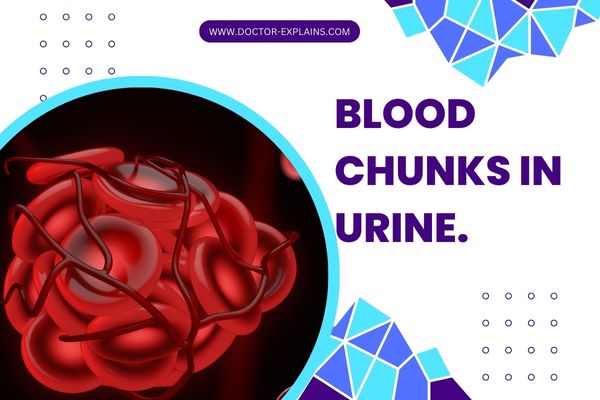Acute Cystitis with Hematuria: Definition, Causes, Symptoms, & Treatments.
Our content is not intended nor recommended as a substitute for medical advice by your doctor. Use for informational purposes only.
You are here because you probably get a diagnosis of (acute cystitis with hematuria) after a doctor’s visit.
I am Dr. Esraa, a nephrologist. And in this article, you will learn everything you need to know about such a condition:
- What does it mean?
- How common is acute cystitis with hematuria?
- Why acute cystitis & hematuria happens & Who is at high risk.
- Symptoms of UTI with hematuria.
- Possible complications.
- Best treatments.
1. Definition: What does acute cystitis with hematuria mean?
Acute cystitis with hematuria means infection of your urinary bladder with the presence of bladder in urine (hematuria). Acute cystitis is the most common urinary tract infection that predominantly affects women and may cause hematuria.
Bacteria (such as E. coli) usually invade the urinary bladder through your urethra, leading to inflammation that is usually confined to the urinary bladder (acute cystitis).
(Acute cystitis with hematuria) is a common diagnosis established by the ICD-10 (International Classification of Diseases).
The ICD-10 system was developed by the WHO (world health organization) and modified by the U.S. (ICD-1-CM) to help doctors classify different diseases.
This article is aimed to be a complete beginner’s guide to the causes, risk factors, symptoms, treatment, and prognosis of acute cystitis without hematuria.
Acute cystitis with hematuria V.S. UTI: what is the difference?
There is no difference between UTI (urinary tract infection) and acute cystitis with hematuria. Acute cystitis is considered a type of UTI.
Classification of urinary tract infection is based on the following:
- Uncomplicated UTI (acute cystitis) with and without hematuria: occurs when the infection is confined to the urinary bladder. Acute cystitis represents more than 90% of the cases of UTI.
- Complicated UTI occurs when the infection spreads to the kidneys (acute pyelonephritis) or when UTI causes severe systemic symptoms such as high-grade fever, sepsis, or septic shock (low blood pressure).
2. How is acute cystitis common?
Acute cystitis is the most common type of urinary tract infection. The vast majority of acute cystitis cases are women due to:
- Shorter and wider urethra (bacteria usually invade the bladder from outside through the urethra).
- The area around the urethral opening is often moist (moisture is a good medium for bacteria to flourish).
- Easier contamination of the urethral opening by stool bacteria.
According to prevalence studies, about 30% of women will experience at least one episode of cystitis (with or without hematuria) during their lifespan (reference).
Hematuria is relatively not common with cystitis. See what blood in urine looks like.
3. Causes & Risk Factors.
Risk factors for acute cystitis include (reference):
- Females: UTI is extremely common in females.
- Recent sexual intercourse.
- The use of spermicide-coated condoms or diaphragms.
- Diabetes mellitus.
- The use of urinary catheters.
- After a kidney transplant (mainly due to immunosuppressive drugs).
A. Infectious cystitis (most common cause).
Cystitis is commonly caused by bacterial infections. However, fungal and viral infections may also occur.
The most common bacteria causing cystitis are:
- E-coli is the most common cause of UTI (75% to 95% of the cases) (reference).
- Others (less common):
- Klebsiella pneumonia
- Proteus mirabilis.
- Staphylococcus saprophyticus.
- Group B streptococci.
- Others.
B. Non-infectious cystitis:
- Chemical cystitis as with soap, bubble baths, etc.
- Drug-induced.
- Radiation cystitis.
- Allergic cystitis (eosinophilic cystitis).
4. Symptoms.
Symptoms of acute cystitis (uncomplicated UTI):
- Dysuria (pain during urination).
- Urinary frequency.
- Frequent waking up to pee at night (nocturia).
- Sudden urge to pee (urgency).
- Bladder pain (suprapubic pain).
- Blood in the urine (hematuria) in acute cystitis with hematuria cases. However, most cases of acute cystitis are without hematuria (blood in urine).
- Cloudy (turbid) urine.
A special notice about UTI symptoms in older women:
Symptoms of UTI in older women (more than 60) are difficult to assess because:
- Many older women have chronic nonspecific urinary symptoms such as painful urination and incontinence) that mimic the symptoms of cystitis.
- Also, they often have urinary frequency (especially at night).
Recurrent cystitis:
Women are most commonly affected with simple acute cystitis. However, a significant proportion may suffer from recurrent UTIs.
Recurrent UTI has defined as two or more infections within six months OR three or more infections within a year (reference).
Studies estimate that 27% of women will experience recurrent UTIs (a second UTI within six months).
Common causes & risk factors of recurrent UTIs are discussed in this article.
Complicated cystitis:
It is a rare event in healthy, immune-competent persons. Complicated UTI occurs when the infection spreads beyond the urinary bladder (no long acute cystitis).
The main signs of complications include:
- Fever.
- Chills.
- Flank pain.
- Lower back pain.
- Nausea or vomiting.
5. Treatment.
The definitive treatment of acute cystitis without hemorrhage is antibiotics, according to urine culture and sensitivity testing.
Other possible treatments & home remedies:
- Taking a painkiller or antipyretic OTC such as paracetamol.
- Drinking plenty of water.
- Hot foments over the bladder (hold a hot water bottle over your lower abdomen).
- Temporarily avoiding intercourse until the condition improve.
- Avoiding irritant drinks such as coffee, fruit juice, or alcohol.
- Pee more often.
- Avoiding spermicide-coated condoms and diaphragm.
- Keep the area around the urethra dry.
- Wipe from front to back when you go to the toilet (wiping from back to front increase the risk of UTI).
- Have a shower rather than a bath.
- Don’t expose the urethra and bladder to irritants such as bubble paths or talcum powder.
- Don’t hold your pee.
- D-mannose sugar tablets or powder.
- Cranberry products. (as juice, tablets, or capsules.
- Avoid too many sugary foods or drinks.
- Tight control of your blood sugar if you have diabetes.
- Evidence-based
- Written by a doctor.
MD, Internal Medicine and Nephrology specialist.

Dr. Esraa A. MagidAuthor
MORE INSIGHTS





